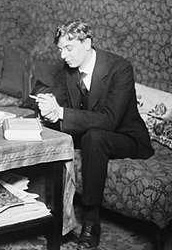Helge Krog facts for kids
Quick facts for kids
Helge Krog
|
|
|---|---|

Helge Krog in 1919
|
|
| Born | 9 February 1889 Kristiania, Norway
|
| Died | 30 July 1962 (aged 73) |
| Nationality | Norwegian |
| Occupation |
|
| Spouse(s) |
Eli Meyer
(m. 1912; div. 1947)Tordis Maurstad
(m. 1949) |
| Parent(s) |
|
| Relatives | Gina Krog (aunt) |
Helge Krog (born February 9, 1889 – died July 30, 1962) was a talented Norwegian writer. He worked as a journalist, wrote essays, and reviewed plays and books. He also translated works and wrote his own plays.
Contents
About Helge Krog
Helge Krog was born in Kristiania, which is now known as Oslo, Norway. His father, Fredrik Arentz Krog, was a lawyer. His mother, Ida Cecilie Thoresen, was a famous feminist. She was the first female student in Norway in 1882. Helge's aunt, Gina Krog, was also very important in the movement for women's right to vote in Norway.
Helge Krog was married twice. First, he married writer Eli Meyer in 1912. They were married until 1947. Later, in 1949, he married the actress Tordis Maurstad.
His Writing Career
Helge Krog finished his studies in 1911. He started working for the newspaper Verdens Gang in 1912. By 1914, he became a critic, reviewing plays and books. He also wrote for other newspapers like Tidens Tegn, Arbeiderbladet, and Dagbladet.
Krog published collections of his articles. One was called Meninger om bøker og forfattere (which means Opinions on books and writers) in 1929. Another collection, Meninger om mange ting (meaning Opinions on many things), came out in 1933.
His Plays
Helge Krog wrote many plays. His first play was a comedy about journalism called Det store Vi (The Great We). It came out in 1917 and was performed in many theaters in Scandinavia. It was a big hit at the Nationaltheatret in Oslo.
Another play, På solsiden (On the Sunny Side), was written in 1927. This play was later made into a movie in 1956. He also wrote Konkylien (The Conch) in 1929. He worked with Sigurd Hoel on the play Don Juan in 1930.
Krog's plays Underveis (On the Way) from 1931 and Opbrudd (Departure) from 1936 were important. They talked about the role of women in society. These plays were still interesting and discussed during the feminist movement in the 1970s.
The "Radical Triumvirate"
Between World War I and World War II, Helge Krog was known as part of the "radical triumvirate." This group included him, Arnulf Øverland, and Sigurd Hoel. They were known for their progressive and sometimes challenging ideas.
During World War II
During the last part of World War II, Helge Krog lived in Sweden. He was in exile, meaning he had to leave his home country. While there, he wrote for a magazine called Håndslag.
In 1944, he published a critical article using a fake name. It was about Nazi Germany's war power and a "6th column" in Norway. This article caused a lot of discussion, even after the war ended. He later published an expanded version in 1946. This version questioned how much Norwegian big industries helped Nazi Germany during the war.
Helge Krog passed away in Oslo in 1962.
See also
 In Spanish: Helge Krog para niños
In Spanish: Helge Krog para niños

